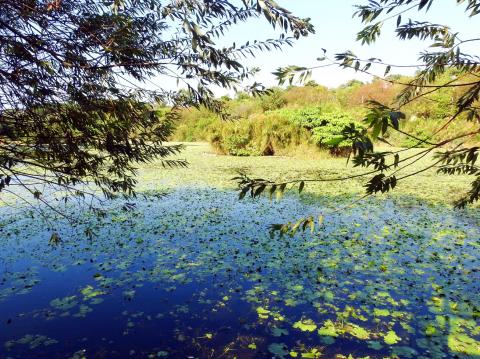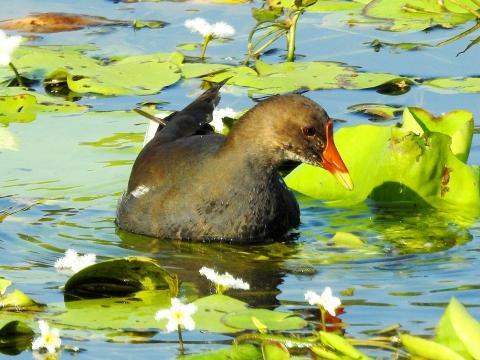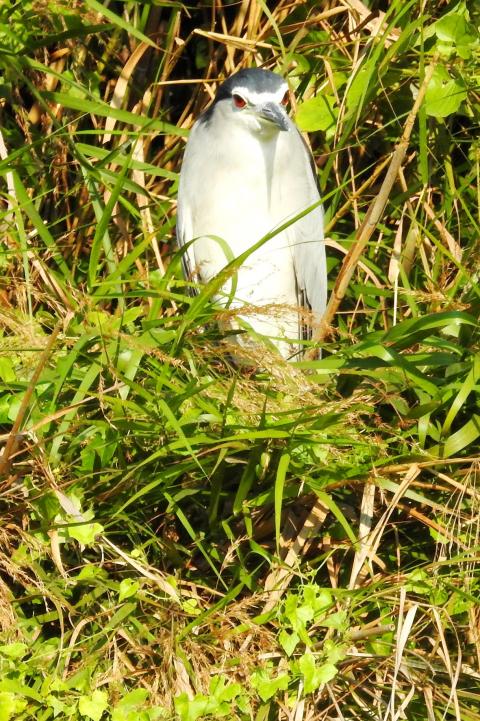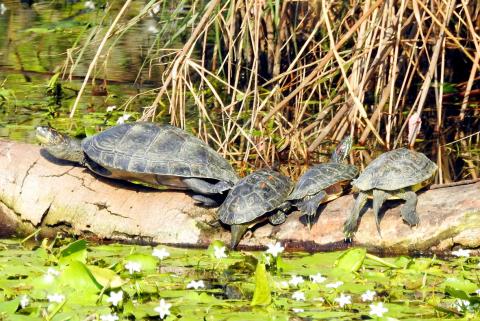Birdwatchers in Taiwan are used to driving up into the mountains, or standing at windswept spots along the coast. Yet the big cities are not totally lacking in places where you can get in a decent afternoon of birding.
In the north, Taipei Botanical Garden (台北植物園) is probably the best location for urban birdwatching. In the built-up core of Kaohsiung, Niaosong Wetland Park (鳥松濕地公園) is the go-to for birders who have just a few hours to spare.
The 3.6-hectare park, named for and located in Kaohsiung’s Niaosong District (鳥松), was the first wetland in Taiwan planned and deliberately brought into existence. Of course, humans have inadvertently created others, such as Gaomei Wetlands (高美濕地) in Taichung.

Photo: Steven Crook
Until the mid-1990s, this parcel of land was occupied by the state-run water utility. After they stopped using it, conservationists lobbied the government to turn it into a wetland education park. The water company dropped its initial objections, and work got underway. In September 2000, the park was ready for its grand opening. Admission is free, the park is open 24/7, and getting there isn’t difficult even if you’re depending on public transportation.
According to the website of Kaohsiung Wild Bird Society (www.kwbs.org.tw/wetland/english/Bird.html) — the NGO selected by the government to manage and maintain the park — 96 avian species are regularly seen around the wetland. The park is also home to up to 30 types of aquatic plants, various turtles, squirrels, insects, amphibians, and piscine species such as Mosquitofish (which Taiwanese call 大肚魚, “big-bellied fish”).
BIRDWATCHING

Photo: Steven Crook
Over the space of a couple of hours on a recent Sunday afternoon, my wife, my son and myself identified more than a dozen different birds. We’re occasional and minimally-skilled birders, but we had a decent pair of binoculars and favorable weather.
We weren’t surprised to see Little and Intermediate egrets. Nor were we especially excited: These white birds are found wherever there’s some greenery and some water.
We were a little too early to find any Great Egrets, but if you go to the wetland between now and May, you’ve a good chance of seeing one or two. To tell these three species apart, look at their beaks. That of the Little Egret is black; its Intermediate counterpart has a short, thick yellow beak that turns red or black during breeding season; the Great Egret’s beak is longer and thinner, and changes from yellow to a darker hue in the breeding season.

Photo: Steven Crook
The Common Moorhen is another year-round resident. Its beak, which is mostly red with a yellow tip, is its most colorful feature. The body is almost entirely black.
In the bamboo on the southern edge of the wetland, several Japanese White-eyes (sometimes called Warbling White-eyes) were hopping around. In the same patch of semi-woodland, there were at least three Taiwan Scimitar-Babblers. This species is endemic, meaning it isn’t seen in other countries. It’s also a particularly handsome bird, thanks to the red-brown around its shoulders.
The Black-Crowned Night Herons were almost as numerous as the egrets. A few had positioned themselves on the banks of the main pond, while others stood on posts or floating branches. An adult specimen can weigh up to 800g, so a good amount of food is required each day. Like some other herons, they have been seen to throw tiny scraps into the water, to lure fish to within striking distance.

Photo: Steven Crook
Just as we were returning to our car, we found another kind of hunter on the very edge of the wetland park. My wife spotted a Crested Goshawk, motionless on a branch, almost within arm’s reach. These raptors are quite a bit smaller than some of the other birds of prey seen in Taiwan. I wondered if many people, seeing its grey-brownish patterning, assume it’s nothing but a well-fed pigeon.
There’s evidence from Southeast Asia that this species adapts fairly well to urban life, so perhaps it shouldn’t be a surprise to see one here. In the countryside they hunt smaller birds, mammals and reptiles. In the city, there are plenty of rats.
If you want to make a full day’s excursion to this part of Kaohsiung, you can also visit Chengcing Lake (澄清湖, open Tuesday to Sunday, 6am to 5:30pm; admission NT$100 for adults but free for Kaohsiung residents), or take in a game at the nearby sports venue which takes its name, Chengcing Lake Baseball Stadium (高雄市立澄清湖棒球場).
Because the lake’s current name was chosen by Chiang Kai-shek (蔣介石) in 1963, some think the authorities should restore the original Taiwanese-language toponym, Toapi Lake (大埤湖). Chiang had one of his many retreats by the lake, as well as an underground military headquarters. The old bunker is now an aquarium called Chengcing Lake Exotic Marine Life Museum (澄清湖海洋奇珍園).
Less than 1km northwest of the wetland, there’s further evidence of the Chinese Nationalist Party’s impact on this side of the city in the form of a landmark building which resembles Taipei’s Grand Hotel (圓山大飯店). The similarity is entirely intentional, because this is a sister establishment of the capital’s landmark called the Grand Hotel Kaohsiung (高雄圓山大飯店). If your budget stretches that far, consider finishing your trip in the cafe on the second floor.
Steven Crook has been writing about travel, culture, and business in Taiwan since 1996. He is the co-author of A Culinary History of Taipei: Beyond Pork and Ponlai, and author of Taiwan: The Bradt Travel Guide, the third edition of which has just been published.

June 2 to June 8 Taiwan’s woodcutters believe that if they see even one speck of red in their cooked rice, no matter how small, an accident is going to happen. Peng Chin-tian (彭錦田) swears that this has proven to be true at every stop during his decades-long career in the logging industry. Along with mining, timber harvesting was once considered the most dangerous profession in Taiwan. Not only were mishaps common during all stages of processing, it was difficult to transport the injured to get medical treatment. Many died during the arduous journey. Peng recounts some of his accidents in

“Why does Taiwan identity decline?”a group of researchers lead by University of Nevada political scientist Austin Wang (王宏恩) asked in a recent paper. After all, it is not difficult to explain the rise in Taiwanese identity after the early 1990s. But no model predicted its decline during the 2016-2018 period, they say. After testing various alternative explanations, Wang et al argue that the fall-off in Taiwanese identity during that period is related to voter hedging based on the performance of the Democratic Progressive Party (DPP). Since the DPP is perceived as the guardian of Taiwan identity, when it performs well,

A short walk beneath the dense Amazon canopy, the forest abruptly opens up. Fallen logs are rotting, the trees grow sparser and the temperature rises in places sunlight hits the ground. This is what 24 years of severe drought looks like in the world’s largest rainforest. But this patch of degraded forest, about the size of a soccer field, is a scientific experiment. Launched in 2000 by Brazilian and British scientists, Esecaflor — short for “Forest Drought Study Project” in Portuguese — set out to simulate a future in which the changing climate could deplete the Amazon of rainfall. It is

The Taiwan People’s Party (TPP) on May 18 held a rally in Taichung to mark the anniversary of President William Lai’s (賴清德) inauguration on May 20. The title of the rally could be loosely translated to “May 18 recall fraudulent goods” (518退貨ㄌㄨㄚˋ!). Unlike in English, where the terms are the same, “recall” (退貨) in this context refers to product recalls due to damaged, defective or fraudulent merchandise, not the political recalls (罷免) currently dominating the headlines. I attended the rally to determine if the impression was correct that the TPP under party Chairman Huang Kuo-Chang (黃國昌) had little of a